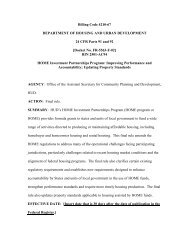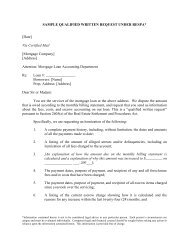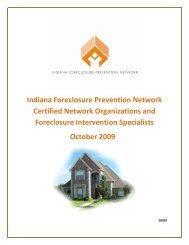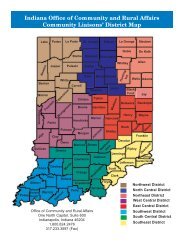17 - Indiana Association for Community Economic Development
17 - Indiana Association for Community Economic Development
17 - Indiana Association for Community Economic Development
You also want an ePaper? Increase the reach of your titles
YUMPU automatically turns print PDFs into web optimized ePapers that Google loves.
2. Communications tools, including:(a) A statewide 800 number that consumers could call to be connected to acertified homebuyer education provider in their area(b) Public service announcements <strong>for</strong> radio and TV to publicize the 800number and services(c) A statewide Web site containing both consumer and practitionerin<strong>for</strong>mation3. Technology—A viable distance-learning system could be replicated andutilized by practitioners and homebuyers across the state, especially in ruralareas.4. Resources <strong>for</strong> working with people with disabilities—Meeting the specialneeds of people with disabilities may require access to resources that manyprograms may have difficulty locating. For instance, most homeownershipeducation curricula are not available in alternative <strong>for</strong>mats (such as Braille oraudio). Homebuyer education providers may not have readily availableaccess to sign language interpretation, or know where to find it. Counselorsmay not have specific experience in working with specialized loan programsand other services <strong>for</strong> people with disabilities. A centralized database ofresources, training opportunities, and the like, well-marketed tohomeownership education and counseling providers, would be a valuablein<strong>for</strong>mation tool to help agencies build their capacity to serve people withdisabilities more efficiently.13B. Make available the appropriate level of resources to allow homeownershipeducation and counseling providers to do their job adequately.1. Many programs simply do not have the necessary funding to provide the fullrange of services necessary <strong>for</strong> high-quality, fully accessible homeownershipeducation programming. The simple fact is that homeownership educationand counseling is not inexpensive.Neighborhood Reinvestment Corporation estimates that it costs, on average,$75,000 to $100,000 per year to run a quality homeownership education andcounseling program. This includes staff time, materials, and overhead. Italso includes the critical accessibility components that may on the surfaceappear trivial, but which can make the crucial difference between whether aclient is able to access the in<strong>for</strong>mation or not. These components includechild care <strong>for</strong> class sessions, refreshments <strong>for</strong> class sessions, transportation(whether <strong>for</strong> instructors or <strong>for</strong> clients) and so on.A statewide commitment to the increased standards of quality andaccessibility will likely mean that many programs will require additionalfunding. To expect programs to implement substantial new policies,<strong>Indiana</strong>’s Homeownership Education & Counseling System (HomeEc) Report — XLII









